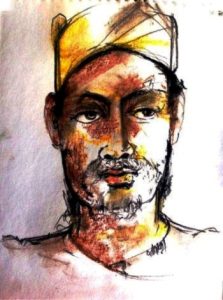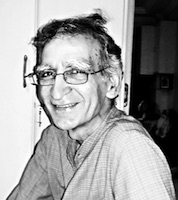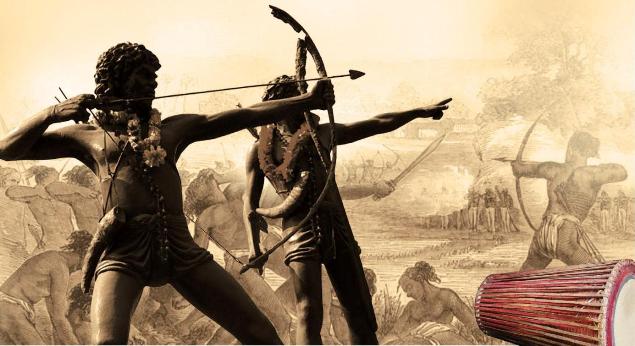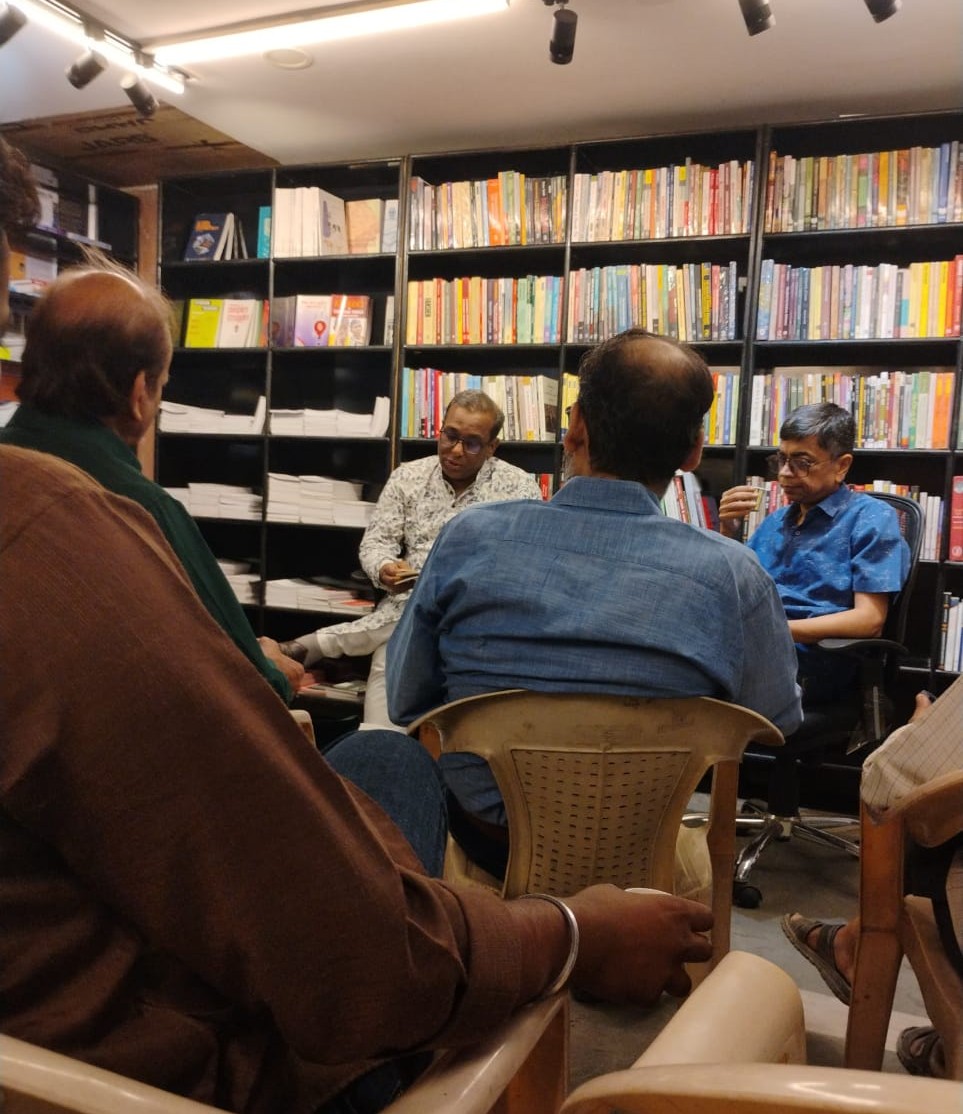India’s philosophical contributions to the world are richly diverse. Its philosophical traditions fall mostly into the patterns of idealist and materialist streams. These streams in turn run parallel to the two main religious traditions: Brahmanism and Shramanism. Brahmanic traditions revolve around Vedas, Smritis and Shrutis; the philosophies of idealism are close to this religious stream. Shramanic traditions focus on this world, are opposed to caste hierarchies and are closer to the practices and beliefs of the ordinary people. Nath, Tantra, Bhakti, Siddha, Shaiva, Siddhanta, etc are materialist philosophies and they run parallel to these traditions.
As such, Brahmanism has been the dominant tradition for the longer period. “Hinduism has largely been a Brahmana-dominated religion which gathered to itself in a somewhat paternalistic pattern a variety of sects drawing on a range of Buddhists, Jains, Vaishanvas, Saivas and Saktas.” (Romila Thapar, Cultural Pasts, p 966, OUP, Delhi, 2000). Ambedkar also points out that Hinduism is basically brahmanic theology. There are shramanic traditions within the fold of Hinduism as well as in Buddhism, Jainism and Ajivikas among others.
Shankar
Shankar (Adi Shankaracharya) is probably the single major philosopher-theologian of the brahmanic tradition. “Brahminic Hinduism was projected largely in terms of philosophical ideas, rituals and icons. He established schools,  temples across the length and breadth of the subcontinent. He reinforced Vedic tradition and asserted the same … His was an attempt to strengthen Brahmanism in the face of other devotional cults which were becoming popular. He became propagator of Vedanta school and Advait (Monism) philosophy. His focus was to rid Brahmanism of the rituals which were the hallmark of the practice of Brahmans. He belongs to the idealist school of philosophy and put forth that the ‘World we see around us is an illusion (maya), for the reality lies beyond and cannot be perceived through existing human senses. Asceticism alone enables one to control the senses and direct them in a manner which permits the glimpse of Reality’.” (Romila Thapar, A History of India, Vol 1, p 185, Penguin, Delhi, 1992) He went on to establish mathas (shrines): Jyothir Matha at Badrinath in northern India with Atharva Veda; Sarada Matha at Sringeri in southern India with Yajur Veda; Govardhan Matha at Jaganath Puri in eastern India with Rig Veda; and Kalika Matha at Dwarka in western India with Sama Veda. In doing so, he emulated the organizational pattern of Buddhist mathas. These mathas became the seats of Shankaracharyas.Another one at Sringeri was added to the four later. “Each of the Matha was associated with a Gotra (as, for example, kashyapgotra with Govardhan Matha of Puri) and the members of the Matha would take on its Gotra, thus subscribing to a form of Sanskritization.” (H. Chakravarty, Quoted in Romila Thapar, Cultural Pasts, OUP, p 896)
temples across the length and breadth of the subcontinent. He reinforced Vedic tradition and asserted the same … His was an attempt to strengthen Brahmanism in the face of other devotional cults which were becoming popular. He became propagator of Vedanta school and Advait (Monism) philosophy. His focus was to rid Brahmanism of the rituals which were the hallmark of the practice of Brahmans. He belongs to the idealist school of philosophy and put forth that the ‘World we see around us is an illusion (maya), for the reality lies beyond and cannot be perceived through existing human senses. Asceticism alone enables one to control the senses and direct them in a manner which permits the glimpse of Reality’.” (Romila Thapar, A History of India, Vol 1, p 185, Penguin, Delhi, 1992) He went on to establish mathas (shrines): Jyothir Matha at Badrinath in northern India with Atharva Veda; Sarada Matha at Sringeri in southern India with Yajur Veda; Govardhan Matha at Jaganath Puri in eastern India with Rig Veda; and Kalika Matha at Dwarka in western India with Sama Veda. In doing so, he emulated the organizational pattern of Buddhist mathas. These mathas became the seats of Shankaracharyas.Another one at Sringeri was added to the four later. “Each of the Matha was associated with a Gotra (as, for example, kashyapgotra with Govardhan Matha of Puri) and the members of the Matha would take on its Gotra, thus subscribing to a form of Sanskritization.” (H. Chakravarty, Quoted in Romila Thapar, Cultural Pasts, OUP, p 896)
Shankar’s major focus was to sanitize Brahmanism and to target Buddhist philosophy and shramanic traditions. He upgraded Brahmanism to counter Buddhism: “Throughout the subcontinent, he engaged in verbal combat with Buddhist philosophers, who taught as Buddha had, such doctrines as the momentariness of all things and the denial of the existence of the deity.” (Sunil Khilnani, Incarnations: India in 50 Lives, p 84, Allen Lane, UK, 2016) Shankar was for the status quo that regarded the world as an illusion. For Buddha, the world was real, where the evils had to be countered and the system of inequality and exploitation fought. On the other hand, Shankar upheld Brahmanism and maintained that “only Brahmins could renounce the world [and thus achieve Moksha]”. Sunil Khilnani points out, “Moreover as Wendy Doniger, professor of History of Religions at University of Chicago, has argued, the belief that the lived world is ‘ultimately unreal generally siphons off the impulse to take action against social injustices, against poverty and cruelty’.” (Khilnani, ibid, p 85)
Shankar’s ideology
He wrote treatises upholding the divine origin of Vedas and their eternal and infallible nature and regarded them as the only source of knowledge. This is what is called monism in philosophy. He denied the existence of matter. He treated reason as being subordinate to the Vedas. He upheld the belief that only the upper castes had the right to study Vedas and therefore the attainment of truth was the monopoly of the upper castes. Shankar’s philosophy was in a way that of the ruling powers, invoking faith in Vedas, legitimizing the right of Brahmins and other upper castes to Moksha, and denying the lower castes access to the Vedas. Vedas here stood for the sole source of knowledge having divine origin.
The opposition to Brahmanic ideology existed in the form of Charvaka and Buddha before Shankar. Post Shankar, the subcontinent saw the emergence of the powerful Bhakti tradition and later the ideologies of Jotirao Phule and Babasaheb Ambedkar. There is a long and illustrious list of philosophers of Shramanism and related steams.
Charvaka
The Lokayat tradition had already challenged the Brahmanical belief that Vedas have divine origin, that they are Brahma Vakya (sayings of Lord Brahma). The Lokayat tradition had profound influence on society. This was a materialist stream in contrast to the idealist stream to which Shankar later belonged. This tradition used logic and reasoning and was concerned with “this worldly” issues. Brahmanism not only opposed the tradition; it also went on to discourage the use of logic in various ways. Indra had to be born as a jackal for the “sin” of using logical thinking; he explains, “[In the previous life] I was attracted to logic, the technique of fruitless argumentation. I was a scholar in a degraded sense, because, in the capacity of a free thinker (haituka), I was vilifier of scriptures (veda-nindaka) … I used to refute Brahmins and was hostile to what Brahmins said. I was disbeliever (nastika) and I entertained doubt about everything. Hence, I was just a fool with pretentious learning.” (Gangopadhayay M.K. 1990, Philosophy in India, Navakarnataka, Bangalore)
This Lokayat tradition was alternatively called Charvaka or Barhaspatya. It meant the rational philosophy, the materialist philosophy. “It was called Lokayat because it was (lokesu) prevalent amongst people.” (Chattopadhayay, 1981) It meant philosophy of the people. It was looked down on as the crass, immoral, consumerist philosophy. It was materialist not in the sense of crass immoral consumption but in the sense that it explained the world as being material, primary and the source of consciousness. It regarded this world as concrete, material and denied everything beyond. Manibhadra explicitly defined Lokayat: lok meant padarth-sartha or padarthsamuha, that is, the totality of material existence. “Thus Lokayat meant not only the philosophy of the people but also the philosophy of this worldliness or materialism.” (Chattopadhayay D., Lokayat, People’s Publishing House, 1998)
Buddha and Kabir

The second major philosophical stream that stood out against the brahmanic ideology belonged to Gautam Buddha. In contrast to Brahmanism, Buddha put forward the doctrine of “impermanence”, the idea of constant change in social production and social relations. In contrast to blind faith, he emphasized the role of reason and individual effort in search of liberation. It is interesting to note here that while brahmanic precepts excluded Shudras and women from the process of gaining knowledge and used the exclusive, elite language, Sanskrit, Buddha said his path was open to everyone and preached in Pali and Prakrut, the language of the ordinary people. He opened up his Sanghas to all castes and both the genders. He focused his attention on the worldly problems rather than being dragged into debates on soul and Brahma. His Ashtangika Marg – eightfold path for the elimination of human misery – comprised right observation, right determination, right speech, right action, right livelihood, right exercise, right memory and right meditation.
This simple message, far removed from the elite-centric brahmanic discourses, appealed to a large number of people. It showed to the low castes a path of liberation from upper-caste oppression and to the women a path to a better status. One of the remarkable aspects of Buddhist teaching is its emphasis on democratic norms. Collective community decisions were projected as the guarantee for the survival of the community and in the interest of all the members of community. Democratic norms, social justice and gender equality emerged in the teachings of Buddha.

In the Middle Ages, Kabir mined and expressed the depths of philosophy in a very popular language. Through his criticism of caste hierarchy and his views on the deeper societal issues, he had a profound impact on the masses. His ideas influenced Sikhism, another major shramanic stream originating in India, a great deal. He refused to recognize caste rules (varnasharam). It is important to see “Kabir’s action as essentially a negation of some gross inequalities of our culture, and not as a mere synthesis of its divergent elements”. (Irfan Habib, ‘Kabir’, in Religion in Indian History, p 153, Tulika, Delhi, 2007)
His is a voice of rebellion against caste and social hierarchy. When Kabir emerged on the social scene, Islam already existed in India. He could see the role of Brahmins in maintaining the caste system among Hindus and that of the Maulanas in preserving the status quo in Muslim society. He raised his voice against the clergy of both religions. Kabir’s voice is primarily against the injustices perpetrated in society due to the power structure legitimized by the clergy. His is the voice of rebellion of the low-caste and downtrodden. No wonder, Ambedkar considered him one of his gurus.
Against this backdrop, it becomes clear that Shankar is not representative of the subcontinent’s philosophy. His philosophy represented the ideas of ruling castes and classes in India. It’s the Lokayat tradition, Buddha and Kabir that truly represent this land. Then why is there an attempt to project Shankar as the philosopher who represents India?
RSS-BJP and Hindu Nationalism
The answer is twofold. One, it is on the agenda of the RSS-BJP, which is at present ruling the country, to turn India into a Hindu nation based on Hindutva. The ideology, Hindutva, in turn, is constructed around brahmanic values of hierarchy based on birth. Shankar is the strongest proponent of Brahmanic values. The politics in the name of religion is aimed at maintaining the status quo of cruel, exploitative social relations and is opposed to the values of liberty, equality and fraternity. Shankar provides the philosophical ground for this brand of politics.
The second part of the answer is related to constructing Hindu nationalism based on the past. As Shankar, the missionary and preacher, wanted to spread his philosophy, he set up mathas in four corners of the subcontinent. It was not a nation, for as Ambedkar points out, Hindus cannot be a nation. Nation has some homogenizing equality. Shankar and Brahmanism, which Hindutva is based on, are opposed to the ideas of equality, so how can one talk of a nation being there just because he established mathas in four corners of this land? The process of formation of our nation begins with the British period when modern industries, education and accompanying values of equality take root. This process is then strengthened by the campaigns of the likes of Jotirao Phule, Savitribai Phule, Ambedkar and Periyar Ramasamy Naicker.
Today, again we are seeing a clash between the two ideologies. On one side are the brahmanic values presented in the politics of RSS-BJP. On the other are Lokayat, Buddha, Kabir, Phule, Ambedkar and other secularizing and modernizing leaders of the Freedom Movement. Because Shankar gives the philosophical foundation for a politics to subjugate the weaker sections, he is the choice of the RSS-BJP ideology.





